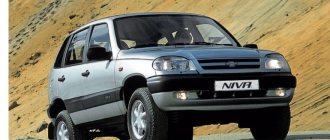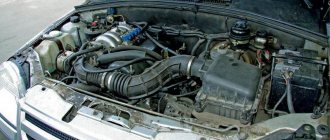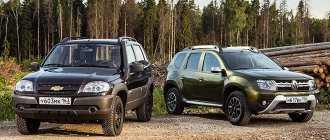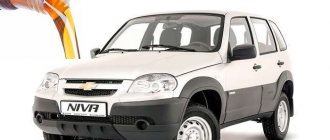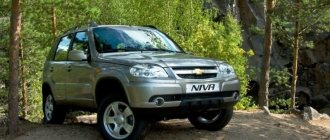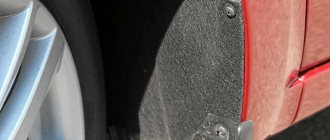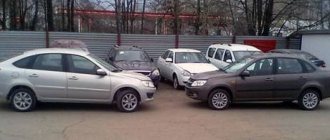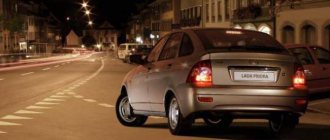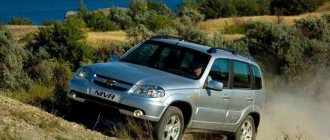For quite a long time, the name “Niva” belonged to AvtoVAZ, and a Soviet-designed compact SUV was produced under it. But the car was becoming outdated, and development of its replacement began in the late 80s. The first concept was presented in 1998 during the Moscow International Motor Show. In the same year, small-scale assembly of this model began, codenamed VAZ-2123 “Niva”.
This is how the new car was produced until 2002, when AvtoVAZ together with created the GM-AvtoVAZ enterprise, aimed at mass production of the model. As a result, the license for the compact SUV itself, as well as the rights to its name, were transferred to the joint project, and since 2004, the original Niva began to be called “4x4”. From the very beginning of production, the Chevrolet Niva was almost twice as expensive as the old model and was a fairly serious competitor to the Kia Sportage, which was produced in Kaliningrad.
Throughout its production history, the Chevrolet Niva underwent only one major restyling in 2009. The appearance of the car has not changed much. So in 2022, the car will undergo another update, which will allow the car to meet modern standards. Also in 2014, a new generation was introduced. However, so far practically nothing is known about him. But almost all the shortcomings of the produced car are known, which is facilitated by reviews from Chevrolet Niva owners.
Body
A proprietary platform was developed for the car; for its time (at the time of release), the car had a rather attractive appearance. In modern realities, the exterior is certainly outdated. The 2009 restyling did not help either, during which the optics and plastic body parts were changed, leaving the hardware untouched. There is no point in describing the appearance of the car and all its configurations, because everyone has been familiar with it for a long time.
During operation, all the flaws in the body structure were found. Iron begins to rot 6-7 years after the start of operation. Blistering of the paint, as well as “saffron caps”, begin to appear at the junction of the gas tank flap with the body, the roof with the pillars, the sills, arches and on the bottom of the trunk lid. The latter, moreover, wears down to iron over time at the point of contact with the seal. Blistering paint may also be seen on the hood. The formation of rust is also facilitated by the antenna, the mounting bolt of which gradually weakens, allowing water access to the bare metal.
It is not recommended to place a jack under the middle part of the car, since this is where the side members are most vulnerable and can simply become crushed when lifted. The insufficient strength of their design also affects when turning, as a result of which they creak, touching the protection. A rubber gasket placed between the parts will help temporarily eliminate extraneous sounds. Rear doors may begin to jam over time due to poor performance of the locks. In order to open them in this case, you need to press the upper corner of the door (the one closest to the trunk), and then try again. The lock will completely break down after 7 years due to corrosion. The driver's door begins to play due to the most frequent use. External handles, regardless of the door, begin to move away from the body over time due to weakening of the fastenings. Problem areas are also the velvet mats, which begin to scratch the glass when the power windows operate. The window regulators themselves, if they are electric, break down after 6 or 7 years of operation.
Bumpers, especially after restyling, are quite fragile and cannot withstand strong impacts. As a result, the Chevrolet Niva, despite its cross-country ability, is not worth going off-road. This threatens chips and cracks on the outer plastic. The rear bumper guides are secured with rivets, which degrade and sag over time. As a result, a fairly wide gap is formed between the plastic and the trunk.
Body and external elements
The body is still quite reliable, with the exception of the wheel arches. If you do not treat them with protective agents in a timely manner and do not protect them with plastic fender liners, pockets of corrosion will appear on the arches very quickly.
It is noted that not enough paint is used to paint the plastic elements of the body, so the paint layer quickly begins to come off from the plastic elements.
At first it was indicated that this car received a nameplate on the radiator grille from Chevrolet.
But our specialists attached it, and they couldn’t come up with anything better than putting the badge on double-sided tape.
As a result, washing and the use of high-pressure washing units can easily knock off the nameplate. Therefore, owners often either wash the car themselves, or at the car wash they warn that high-pressure water should not be applied to the nameplate.
Many people note that the head light on the Chevrolet Niva is very decent, but even here it was not without troubles.
After washing or driving in the rain, condensation forms on the inside of the headlight lenses.
Regarding the headlights, the use of weak housings for the side lamps is also noted. As a result, the housings quickly melt.
After purchasing a car, it is better to immediately replace the standard lamps with LED ones to avoid this problem.
Interior and electrical
Inside, the car is a mixture of cheap Chevrolet models, designed for third world countries, and a VAZ car, starting with the 10th family. The dashboard is made of soft plastic, the dashboard is taken from tens. The steering wheel is three-spoke and is only height adjustable. The dashboard is taken from the “ten”. After restyling, many compartments, pockets and glove compartments appeared in the cabin, which the owners of the previous generation so lacked.
Like the body, the interior is filled with minor faults. After 30 thousand km in the car, they prefer to sing from different places, especially in the area of the dashboard joints. Over time, from the hot sun, the lid of the upper glove compartment begins to deform, which is why it warps, showing cracks and stubbornness when closing. Water may begin to leak through the antenna mentioned above, as well as through the steering shaft seal or heater.
Ergonomics remains at an average level, because there are few instruments on the center console. But even at this, the developers managed to “mess up” by placing the front row power window keys on the center console, right behind the gear shift lever. The latter also has an inconvenient location, near the “lower road”. This causes problems when engaging reverse and downshift at the same time. Torn lever boots can cause cold drafts in the car interior.
As for electrics, the Chevy Niva has its own trump card. Owners have repeatedly noticed how the car turned on the ignition without a key. To do this, just turn on the dimensions and low beam. The fact is that the designers equipped the light button with a plus, which is also connected to the ignition. In addition to these “tricks”, several more negative aspects of electrics can be noted:
- The fuel level sensor fails after 60 thousand km.
- The coolant temperature sensor has the same service life. In addition, its performance decreases if, in addition to it, other devices are also working.
- The standard key fobs responsible for the operation of the central lock are poorly soldered. As a result, they have a short service life.
- If there is poor contact in the mounting block, the rear window heating and heater fan fuses will burn out.
- If the lamp is not fully inserted into one of the dimensions, this will lead to melting of the headlight reflector, as well as burning of the socket.
- The standard generator does not hold a charge well and kills the battery, so after purchase it is recommended to replace it with a more powerful one, rated at 115 A.
Chevrolet Niva engine tuning
Before carrying out various actions on your car and changing its appearance, you should pay attention to the power unit. The engine undergoes tuning much more often than any other parts
Thanks to this operation, engine power can be significantly increased. You will achieve this result if you replace the factory pistons and camshaft in time. In addition, it is recommended to modify the gas distribution mechanism together with the valve system, as well as install a balanced flywheel.
When changing all these spare parts, you should know when to stop. Some motorists replace the standard engine with a unit with a displacement of 5 liters. Experts believe that such an off-road vehicle burns a lot of fuel and also causes discomfort when driving.
Many have come to the conclusion that it is better to use a standard internal combustion engine, the working volume of which is up to 17,000 cubic cm. This is a fairly noticeable increase in power. This result can be achieved by replacing the pistons. When choosing these parts, you should choose products with a large diameter. Typically, tuned pistons are classified into two types: forged and cast.
A product made of reliable and durable material increases the service life of the pistons. However, experts refer to the fact to keep every detail in balance. If the center of gravity shifts relative to the piston pin axis, this can lead to tilt. At the same time, the walls are damaged much faster, compression decreases, etc. When choosing pistons for a Chevrolet Niva, you need to be careful.
More optimized ventilation of the Shevi Niva combustion chamber is achieved thanks to tuned valves that are T-shaped. If you properly treat the locking surface of tuned valves, you can achieve excellent sealing of the cylinder. With the help of a low mass of the plate, the specified temperature regime of the valve is maintained
It is important to note that the T-shaped valve almost never burns out
An upgraded camshaft for tuning can be classified into three categories. Tuning the Chevrolet Niva engine will make you feel as safe as possible when driving off-road.
In addition, it is important to maintain the driving pace if a lower gear is engaged. For this purpose, you will have to select the appropriate camshaft
Important! Manufacturers produce various modifications of tuning shafts for Chevrolet Niva SUVs. Therefore, they have to be numbered in order to select the appropriate model
When choosing a tuning kit for a gas distribution mechanism, pay attention to the availability of software firmware. Thus, in the future the Chevrolet Niva engine will operate correctly
You can contact a car service center where turbines will be installed.
Engines
Throughout its entire production, the car was equipped with a single VAZ 2123 engine, which was based on the injection model installed on the classic Niva. In technical terms, these engines are almost completely identical: the power was 80 hp and the volume was 1.7 liters. The only difference is the change in the location of the fasteners, both the unit itself inside the body and the attached parts.
Even for a light Chevrolet Niva, this engine was quite weak, and the car was reluctant to accelerate even for its time. In addition, the unit has almost all the diseases of VAZ engines, including noise, oil consumption, as well as a tendency to vibration and extraneous noise. In addition to them, the chain has a rather weak tension system, which at one point can allow it to jump onto a cog. After this, in the worst case, you will have to pull the “honey mushrooms” out of the head of the block. As a result, the engine resource is quite short and amounts to only 150 thousand km. Even at the factory itself they don’t really believe in this engine, and they set the resource at 80 thousand km.
But, in addition to mass production, about a thousand cars with the FAM-1 prefix were produced. They differed in that under their hood there was a more powerful, 122-horsepower unit from Opel - Z18XER. Its volume was 1.8 liters. The engine pulled the Niva well both on asphalt and off-road. Of course, it had its shortcomings, but they happened less often, and were less felt, compared to its Russian counterpart.
The main drawback was the lack of hydraulic compensators, which is why the valves need to be adjusted every 100 thousand km. The thermostat on the Z18XER is no better than on the VAZ, and often breaks down before the stated mileage. The same can be said about the ignition module. The last widespread problem is oil leakage observed from the oil cooler. This is a fairly common thing and shouldn’t be particularly surprising. In addition, there is no need to worry, because repairs will cost mere pennies. And despite most of the faults, the device has a service life almost twice as long as that of the VAZ, which ranges from 200 to 250 thousand km. But in order for the engine to serve its life without any complaints, it needs to be treated with care: timely maintenance and the use of only high-quality oils and fuel.
Pros and cons of the Chevrolet Niva compared to a regular Niva
Let us highlight the characteristic features relating to both the 21st Niva and subsequent models VAZ-21213 and VAZ-21214. We will not consider the Long Niva (VAZ-2131), pickup truck (VAZ-2329) and other modifications. So, let's start with the undeniable advantages of the regular Niva compared to the Shevik:
- Patency. Due to the short wheelbase, the 21st model has better geometric cross-country ability.
- Price. In the same condition, a regular Niva will be 1.5-2 times cheaper than a Shevik.
- Availability and low cost of spare parts. Especially for body parts.
- "Psychological passability." An ordinary Niva is not so scary to be scratched or slightly dented, unlike a Chevrolet.
- The best predisposition for off-road tuning.
Now let's list the disadvantages of the 21st Niva compared to the Chevrolet Niva:
- Low level of comfort. Noise, vibration, lack of power steering (on old Nivas), uncomfortable driving position.
- Outdated design. Although this is a controversial point, because the design of an ordinary Niva is recognizable all over the world, which cannot be said about the Shniva.
- Poor aerodynamics.
- Poor handling on the highway.
- Cramped interior. This includes an uncomfortable seating position in the back row and a small trunk.
Everything is clear with the advantages and disadvantages of the regular Niva compared to the Shevik. Let's move on to the Chevrolet Niva.
Let us list the main advantages of the Chevrolet Niva:
- Modern and quite successful design.
- Passive safety. Although its level is unacceptably low, it is still slightly higher than that of a regular Niva. Chevy cars of recent years are preferable in terms of safety.
- Relatively high level of driving comfort. Less vibration, less noise, comfortable driving position, power steering.
- Spacious salon. This also includes a comfortable back row, seating and a relatively spacious trunk.
- Not bad aerodynamics.
Now the disadvantages:
- More expensive than a regular Niva, both in purchase and in maintenance and repair.
- Poor cross-country ability due to the extended base and lower bumpers.
- An abundance of plastic, especially on new Sheviks. A controversial point, because plastic protects the body from minor damage (scratches, chips).
- Weak engine. The dynamics of Shevik are worse than those of a regular Niva.
- More mass. On marshy soils this is a minus, but in other cases it can be a plus (shallow mud, loose snow).
Plastic protects the body from scratches and chips
It is also worth paying attention to one more point - body rigidity. It seems that the three-door car should have it higher, but the Shevik has thicker side members, so not everything is so simple
Transmission
Like the native VAZ engine, the Chevrolet Niva’s gearbox is also full of surprises. From the outside it looks like a standard five-speed manual. But if you try to change gears, you can immediately feel the play coming from the spline joints. And the older the car, the greater the play. In addition, the device constantly hums while moving and creates additional vibrations, which are perfectly transmitted to the lever when trying to shift at 2500 or 3000 thousand rpm. To fix the latter, you will have to replace the fork, as well as some bearings. After 100 or 120 thousand km, the box begins to “deflate”, and you will have to apply force to switch. After the onset of this disease, you can safely expect especially loud howls in third gear.
The mechanism mechanism requires adjustment from time to time. Otherwise, fifth or reverse gears may fall out. Another “sore spot” was the clutch slave cylinder boot, which can tear or crack even on a new car.
In addition to the usual gearbox, the Niva also has a transfer case, which you will need to get used to working with. In order not to “kill” the gears of the mechanism ahead of time, you need to independently select the moment when the revolutions will be synchronized, and only then turn on the clutch lock. The front gearbox begins to howl after 130 thousand km, and after another ten thousand the old CV joint will require replacement.
Niva with turbine
The most common way to add power to an engine is to install a turbine or compressor, which will significantly increase the volume of air entering the power plant.
Installing a turbine is not a complex tuning solution, since the turbine itself has a fairly simple structure. The supercharger and turbine impellers are mounted on the same shaft, and the exhaust gases are the drive. Thus, we can observe the most efficient use of energy from combustion products in a car. The absence of interaction between the crankshaft and the turbine shaft also increases the efficiency of the power plant.
In general, the Niva engine can and should be modified, and then your car will become more powerful and last much longer. This is what we should strive for!
Suspension
The car's suspension is quite good and, in tandem with a fairly high ground clearance, helps to easily overcome difficult obstacles. Changes in its design depend on the year of manufacture and the intended use, however, the problems for almost all types of suspensions are similar. Troubles begin after overcoming 60 thousand km, when extraneous knocks begin in the rear part of the suspension, which are clearly audible when driving over uneven surfaces. The reason for this is tired rubber bands on the rear links. Visually they will seem intact, but the inside will be very worn out.
Silent blocks last up to 80 or 100 thousand km, and after a characteristic knock appears, you can stretch them, after which they can travel several tens of thousands more. Ball ones, on average, run 60 thousand km. Wheel bearings do not have the best design, which is why they need tightening every 30 thousand km. And this is provided that they travel about 90 thousand km.
The weak points in the front suspension are the rubber-metal hinges of the right upper arm. They are located too close to the engine exhaust system, as a result of which they become very hot and can become deformed. Another weak point can be the shock absorber rods. To avoid their breaking off-road, when replacing shock absorbers, it is not recommended to broach them while the car is in a suspended state.
What kind of pain can you encounter?
A used Chevrolet Niva for 200 thousand, regardless of age, has very unpleasant diseases:
- Constantly leaking crankshaft seals
- The hubs will have to be replaced immediately
- The antifreeze reservoir bursts; it’s better to carry a spare one with you.
- If a Chevrolet Niva has a mileage of more than 100 thousand kilometers and toxicity standards are higher than Euro-2, then you should immediately prepare to replace the catalyst or chip it. The neutralizer is a weak point and is very picky about gasoline.
- Transfer case wear
- The engine runs no more than 250 thousand kilometers without repair, so a car for this money will most likely have oil burns and a drop in power over time.
In general, it is necessary to constantly monitor the levels of all technical fluids, especially in the transmission and power steering. But there is one pleasant plus - the low cost of spare parts. True, it may not be covered with the best quality.
The electrics of the Chevrolet Niva are also not the most reliable. However, this only applies to the pre-restyling version. Most often, window regulators fail, but in most cases the faults can be corrected by simple “knee-jerk” repairs.
Bottom line
Up to 60 thousand km, the Chevrolet Niva is a good economy class foreign car, designed both for traveling around the city and for getting out of the city into the garden or nature. After passing this limit, the car becomes a typical representative of AvtoVAZ with weekly breakdowns and extraneous sounds. The car failed to get rid of almost any of the shortcomings of its predecessor models, even after a slight restyling. At the same time, all the disadvantages described above are not very significant and will allow you to fix things yourself or go to a service center.
For several years now, the release of a new, updated generation of Chevrolet Niva has been expected. This time the car looks quite modern. And the latest car models assembled at AvtoVAZ (regardless of the brand), although slightly, have improved their quality. Therefore, we can only hope that the new generation can become at least a little better than its predecessor, who, to be honest, is long overdue for retirement.
Suspension and chassis
As for the chassis, everything is clear. Although it is called Chevrolet, it is Niva. Particular attention should be paid to ball joints, torque rods, hubs and seals. The latter, by the way, flow quite often. The front wheel bearings fail before even 30,000 km.
The Niva Chevy steering rack can be repaired a couple of times during operation over 3-4 years, but replacing it with a new one does not give the long-awaited effect. Therefore it is easier to repair. Another problem is the struts, which can leak almost immediately after off-road driving. The same applies to CV joints, which do not like loads.
Chevrolet Niva suspension, bottom view
Reviews
Anastasia Kuropatkina, 36 years old, Novgorod.
I bought a Chevy Niva because I liked the appearance. I don’t ride off-road, only around the city. Consumption during quiet driving is 9-11 liters, although many argue with me that this simply cannot be. My answer to this is this: it depends on who drives how. The seats are comfortable and maneuverability, in my opinion, is good for a car of this size. As for the dynamism, 110 on the highway is quite enough for me, and the car holds the road smoothly. Parking on the Niva is convenient - any curb is not an obstacle. The body has no serious problems; I haven’t seen any saffron milk caps or peeling paint anywhere yet (the car is from 2006). Breakdowns are generally rare, and spare parts are cheap, so I really like the machine and recommend it to everyone.
Leonid Volkov, 32 years old, Naberezhnye Chelny.
I purchased a Chevrolet Niva in 2011 from the showroom. After the lowered “nine”, a ride on it is like sailing on a ship on the waves. The suspension works as it should. But this is probably where all the advantages end. Over time, the seats began to become loose and roll on the rails. The tires are pretty weird. At one time, as an all-season vehicle, it copes well with snow, and in the summer it stands confidently on the asphalt. But as soon as you drive into the mud, problems immediately begin and the car gets buried. Once on the road at a speed of 110 km I drove into a hole that I did not notice on the highway. The car played with the suspension to the fullest, and as a result, something began to rattle. After disassembly, it turned out that the bump stop, which is located inside the spring, was bent and burst. In general, this is probably all, since soon after that I sold the car. In general, I didn’t really like the Chevrolet Niva: it overheats too much off-road and doesn’t handle well on the highway at all.
Anton Griboyedov, 43 years old, Omsk.
Before the Chevrolet Niva, I only drove Russian cars: “nine” and “tag”. Of course, I have driven in foreign cars, but it is pointless to compare the Niva with them, since they are very different from each other. “Shniva” is quite convenient for family trips, especially outside the city. Visibility is good and there is plenty of space, although the trunk is a bit small. There is little comfort here, but with the right tires the car feels great both in the forest and in an open field. The geometry of the body allows you to climb fairly steep slopes and overcome high obstacles. The maximum consumption was 15 liters per 100 km, however, on average, the figure fluctuates around 11-12 liters.
Roman Zinurov, 48 years old, Nizhnye Sergi.
When purchasing the Niva, Chevrolet expected to purchase a car for active recreation. The car overcomes curbs, potholes and bumps perfectly, which cannot be said about mud and other slush. The stability is excellent, even in icy conditions the Niva rushes confidently and along the desired trajectory. Rear visibility is poor; you can't see anything through the small window, which makes reversing difficult. It’s quite difficult to move around in the city because of the backlash, but outside of it it’s simply beautiful. The car is perfect for those who often travel out of town, but for those who live exclusively in the city and go out into nature no more than five times during the whole year - I highly recommend it: you will only be tortured.
Pavel Nikolaev, 31 years old, Syzran.
Chevrolet Niva purchased in 2015. I took it because of its relative budget. Having driven the car for about two years, I can say that apart from high ground clearance and good visibility, there is nothing special about the car. Before I had even driven 40 thousand, the lid of the antifreeze tank depressurized. As a result, the car was enveloped in sweet smoke, and the windshield was covered with a greasy film. But this is just the beginning. During the period that I drove the car, the following have already been changed: the alternator belt, the front crankshaft oil seal and the hydraulic chain tensioner. I also constantly hear extraneous noises: creaking, knocking, howling. The box has: attention (!) “designed play”, that’s how they described it to me in the salon after contacting me. In general, the car is for a very rare fan, which I am not.
Rust on the body
We probably won’t discover “America,” but the fact, as they say, is obvious. Alas, as the owners write on the forums, the paintwork still leaves much to be desired. Varnish and paint gradually give way under the pressure of weather conditions, “salty” winters, and the scorching sun. The result is microcracks, the air begins to oxidize the metal, and unpleasant brown areas of corrosion appear.
But this is not so bad, the worse thing is that under the pressure of weather conditions and reagents in large cities, anti-corrosion protection gives weakness. This is where the most unpleasant things begin - rot spreads in closed cavities, under the bottom and in other hard-to-reach places.
According to users, rust may appear in the third or fourth year of operation.
In this regard, we advise you to update the anti-crust layer once a year by pouring the composition into the closed cavities of the underbody.
